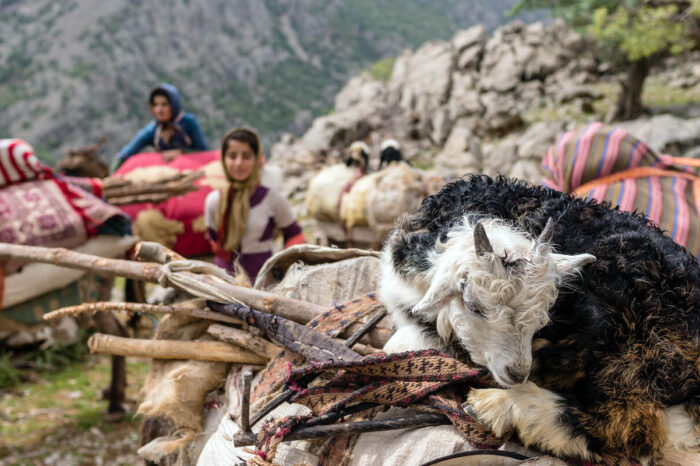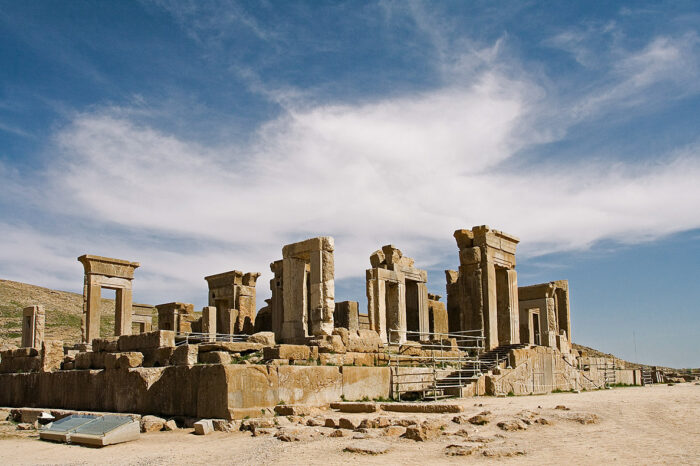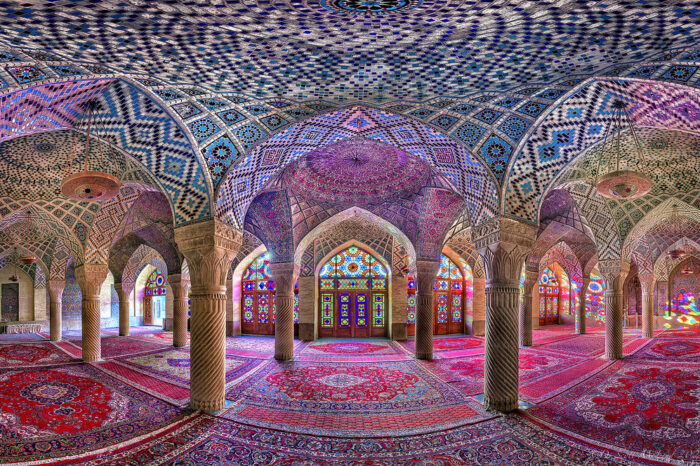-
English
Shiraz
Related Tours
The oldest written documents showing shiraz background and its construction date are related to clay tablets of Persepolis representing the words ‘Shi Razi Ish’.
Researchers believe that the construction of Shiraz was in the Achaemenid era as a construction workshop for Persepolis. Shiraz was the capital of Iran in the past and four periods ( Deilamian, Atabakan, al‑Alinjo, Almozaffar, Zand era). Shiraz city an area of 1,264 kilometers and a rectangular shape is located in southwestern Iran. Shiraz city neighbors are Marvdasht and Sepidan in the north, Servestan and Kharameh in the east, Kavar, and Firoozabad in the south, and Kazeroon in the west. Shiraz on four sides is surrounded by the mountain that is added to the beauty of this historic plain and moderate climate.
Tomb of Hafez
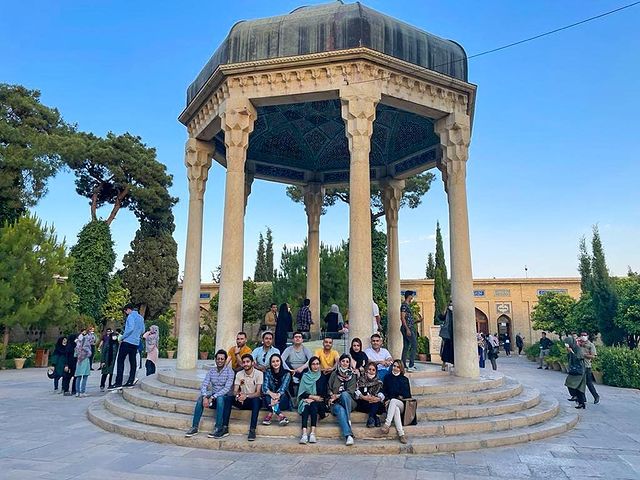
The current structure of Hafezieh (the tomb of Hafez) was designed during the reign of Reza Shah by André Godard.
Khwāje Shams-od-Dīn Moḥammad Ḥāfeẓ-e Shīrāzī, known by his pen name Hafez (حافظ, Ḥāfeẓ, ‘the memorizer; the (safe) keeper’; 1325–1390) or Hafiz, was a Persian lyric poet whose collected works are regarded by many Iranians as one of the highest pinnacles of Persian literature.
His father before could raise his son, passed away. Hafez continued acquiring knowledge in sciences and literature beside the great teachers of that time like Seyyed Sharif Jorjani and Abu Abdollah Qavvamodin in Shiraz. He then entered the world of mysticism. he has memorized the whole Quran and read it in fourteen stories; so he is called Hafez. Hafez Divan has more than six thousand bits that contain odes, sonnets, couplets, quatrains, and suites. the most famous of them are his poems.
Hafez is one of the famous poets of the 8th century Hijri era. The eight columns constructed in the Hafeziyeh are symbolic of that century. On the other hand, these eight columns signify eight gates, in reality representing the eight gates of paradise, with all eight gates opened to Hafez. and over the centuries after his death; his book is being published in various languages in the world. undoubtedly, we can say that in every Iranian house and beside Holy Quran, a cover of Hafez Divan Could be found. Hafez of Shiraz was greatly fond of his hometown, but once invited by the king of Hindustan, he decided to embark on a journey to this land. However, when faced with the turbulent sea, he felt fear and despair, abandoning the trip and returning to his homeland, Persia. For the second time, he set out on a journey to Yazd at the invitation of the ruler of that city. Initially, he spent good days in Yazd, but gradually the situation changed, and he confronted a dictatorship. Hafez was imprisoned in a prison known as Suleiman prison. After his release, Hafez returned to Fars and spent the rest of his life in Shiraz.
Hafez lived during the reign of Al‑Mozaffari and Al‑inju and described their goodness in his poems. in his long life of 65 years, seven kings have reigned in Shiraz. after his death in 792 A.H., he was buried in Mossalla Cemetery and today nothing remains of that cemetery.
His burial place was just a simple grave. in the reign of Mirza Abulqasem Gorekani, Shams al‑Din Mohammad Yaqmaei the minister of the ruler of that time erected a domed building on his grave, and in front of it, there was a large pool full of water that filled by Roknabad Sources.
بده ساقی مِیِ باقی که در جنّت نخواهی یافت کنار آب رُکنآباد و گُلگَشت مُصَلّا را
Translation:
Give the remaining wine, O cupbearer, for you won’t find it in paradise,
Beside the water of Ruknabad and the prayer niche of Golgasht Mosalla.
Give the remaining wine, O cupbearer, for you won’t find it in paradise,
Beside the water of Ruknabad and the prayer niche of Golgasht Mosalla.
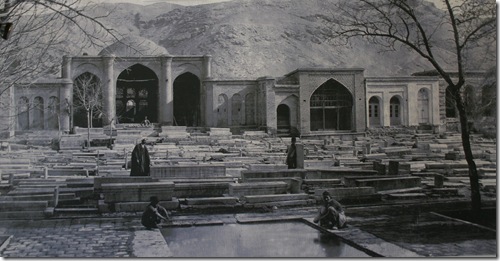
The photo is related to three years before the installation of the Hafezieh mausoleum, in the year 1316 AH (Islamic calendar).
The huge and magnificent tomb of Hafiz was built in Karim Khan Zand’s era in the year 1188 A.hl.. This mausoleum consists of four unified columns, distinguished by paintings depicting flowers and bushes, which still bear traces of colors on the remaining parts of the columns, unlike other columns.it had two open parts in the north and south and also two small rooms on the corners of it. the tomb was located in the northern part and there was a large garden in the southern part of the site.
At that time, Karim Khan Zand ordered a large marble stone from Maragheh to be cut into two pieces. One piece was used for the pulpit of the mosque, and the other was placed on Hafez’s tomb. He instructed Haj Aqassi Beig Afshar to be laid by the poems of Hafez lyrics on the tombstone.
Translation:
Announce the good news of your union, for I will rise from the depths of my soul,
I am the sacred bird, and I will soar beyond the entanglements of the world.
Under your guardianship, even if you consider me your servant,
I will rise above the limitations of existence and space.
O Lord, send a rain of guidance from the clouds of enlightenment,
Before I, like dust, emerge from the midst.
Sit with me over my grave with wine and a musician,
So that, with the fragrance of your essence, I may dance in ecstasy.
Arise and manifest your sweet gestures, O enchanting idol,
So that I may raise my hands in celebration from the core of my being and the world.
Though I am aged, for a night, embrace me tightly in your arms,
So that by dawn, rejuvenated, I may rise from beside you.
On the day of my death, grant me a breath’s respite for a farewell meeting,
So that like Hafez, I may rise from the soul and the world.
During the reign of Mozaffar ad-Din Shah Qajar, an iron railing was placed around Hafez’s tomb. On top of it, an inscription reads, “To Ahad Khosrow Adel Mozaffar ad-Din Shah,” referring to the time of Mozaffar ad-Din Shah.
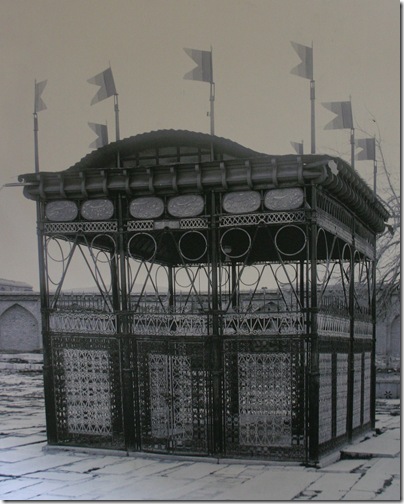
A photo of the mausoleum during the time of Mozaffar ad-Din Shah Qajar – the designer of the mausoleum (Mazin Al Doleh).
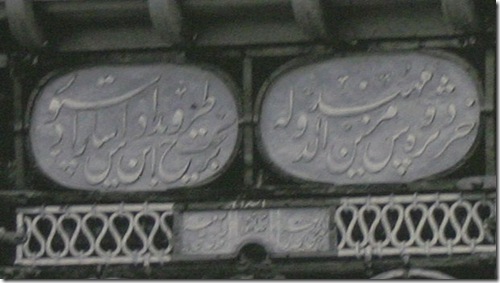
To the reign of the just king Mozaffar ad-Din Shah / By the command of his free-born son, Malik Mansur,
The enlightened engineer, Mozzanel-Doleh, / Implemented the design and laid the foundation by order.
Started in the year nineteen hundred and nineteen (1319 AH) / The radiance of sovereignty adorned this side of the mausoleum.
After a while, during the time of Pahlavi I, the command was given to entrust the current site of Hafez’s tomb to Andre Godard, a skilled designer. He then created this extraordinary architectural masterpiece.
Saadi Tomb
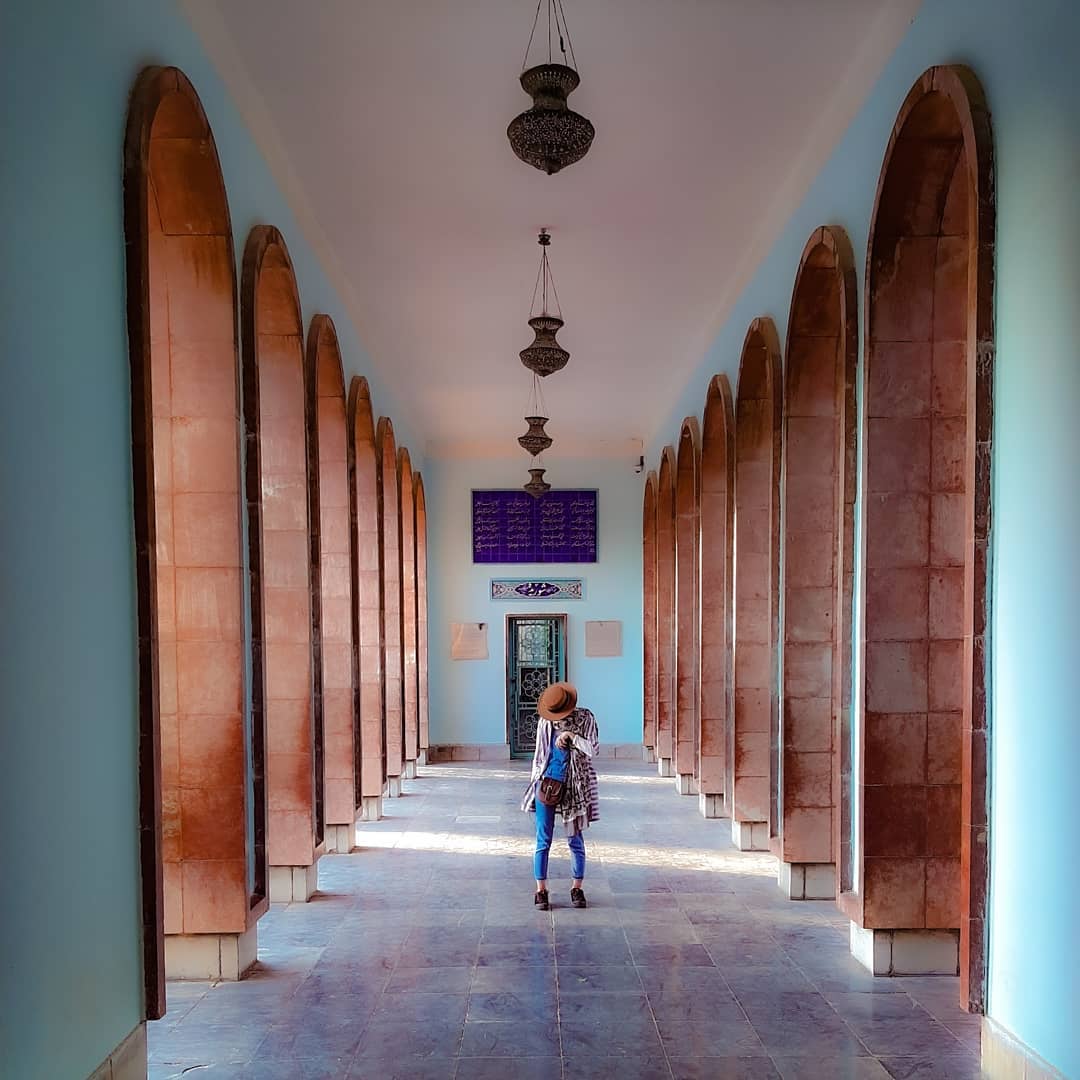
Moshrefoddin Mosleh Ibn‑e abdollah Shirazi known as “Sa’adi” was born in Shiraz in the early seventh century A.H.
Sa’adi Shirazi is the greatest poet of Persian literature who has appeared after Ferdowsi and is still well known in the world as a great poet of his time. he passed away in Shiraz in 690 A.H. The first tourist who has visited the tomb of Sa’adi was called “Ibn‑e Battuta” a Moroccan traveler in the year 748 AH, 57 years after Sa’adi’s death. Based on current evidence, Sa’adi Tomb in the recent century has been restored.
Karim Khan Zand reconstructed it in 1187 A.h. He built a two‑floor building with brick which had two rooms on either side. Sa’adi was buried under the side of the eastern room and it’s inlaid and surrounded by wooden fences. later in the western chamber was made a tomb of “Shorideh Shirazi,” a famous poet of the thirteen century A,h.
the first monument of Sa’adi was set up in 1948, and then due to the suggestion of the Fars national works association and by the effort of Dr. Ali Sami and Ali Asghar Hekmat, a tomb that could glorify Sa’adi great dignity was rebuilt. This monument has a beautiful dome and there is a porch like a chamber on the front side of it which has been held by eight stone columns. in the new building tomb of Sa’adi is located in an octagonal edifice with a very high tiled ceiling. at the lower area of the surface of this garden, a spring with pure water is outflowing. in the middle part of this place, there is a pool which is called “Howzeh Mahi”. Based on an old tradition, people in Shiraz throw coins in it to wish their dream come true.
Karim Khan Zand reconstructed it in 1187 A.h. He built a two‑floor building with brick which had two rooms on either side. Sa’adi was buried under the side of the eastern room and it’s inlaid and surrounded by wooden fences. later in the western chamber was made a tomb of “Shorideh Shirazi,” a famous poet of the thirteen century A,h.
the first monument of Sa’adi was set up in 1948, and then due to the suggestion of the Fars national works association and by the effort of Dr. Ali Sami and Ali Asghar Hekmat, a tomb that could glorify Sa’adi great dignity was rebuilt. This monument has a beautiful dome and there is a porch like a chamber on the front side of it which has been held by eight stone columns. in the new building tomb of Sa’adi is located in an octagonal edifice with a very high tiled ceiling. at the lower area of the surface of this garden, a spring with pure water is outflowing. in the middle part of this place, there is a pool which is called “Howzeh Mahi”. Based on an old tradition, people in Shiraz throw coins in it to wish their dream come true.
Arg of Karim Khan
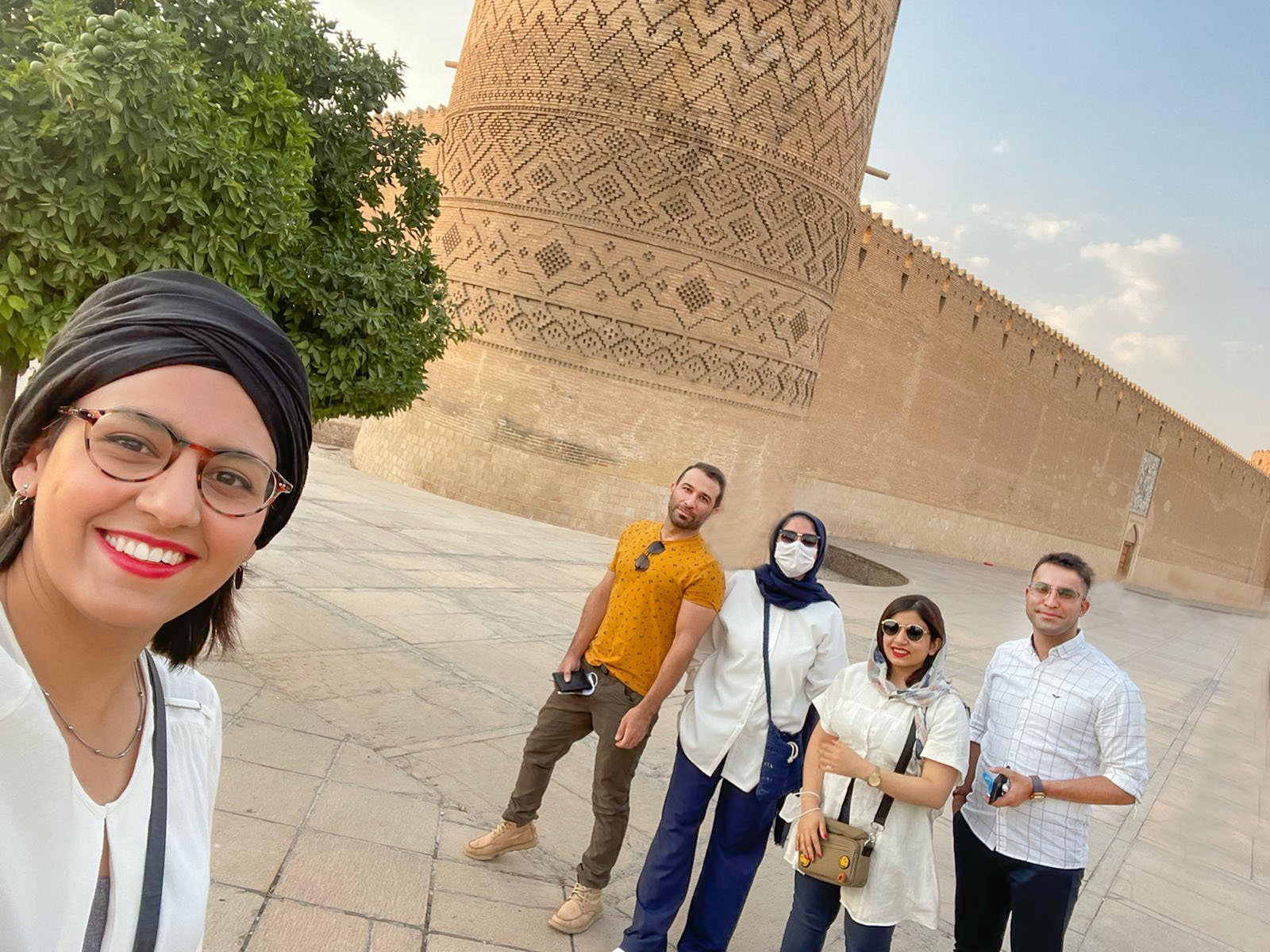
Karim Khani Citadel is the most important and supreme building of the Zand era which was made by the order of Karim Khan Zand 1180 A.H.
This Citadel has been the center of the Karim Khan Zand dynasty and was also the home of. This building has been built with an infrastructure of 4,000Square meters and land, and an extent of 12,800 square meters.
Brick walls of this building are 12 meters high and in all four corners of the Citadel, exists a tower with a height of about 15 meters. On the body of the walls and towers could be seen simple and beautiful brick paintings, on the entrance of the Citadel, the battlefield of killing a spook by Rostam has been stamped with seven colors tiling. The beautiful tiling was added to the Citadel in the Qazar period. a vestibule makes up the entrance of the Citadel which enters the backyard from one hand and to an inner courtyard from one hand and an inner courtyard on the other hand. The Citadel has a northern alcove (winter staying), a southern one (summer staying), and the western building has four seasons during the whole year. unlike the exterior surface of the citadel, the interior side has a beautiful view.
within the Rooms has been decorated with continental figures such as flowers, bergamot, and birds. after the collapse of the Zand dynasty and the rise of the Qajar dynasty, the citadel became a place for governors and rulers and until the early period of the Pahlavi era was used as a prison. Part of the decoration of this citadel has been transferred to Tehran in the Qajar dynasty. This monument was registered as a national work in 1973 AD.
Vakil Mosque
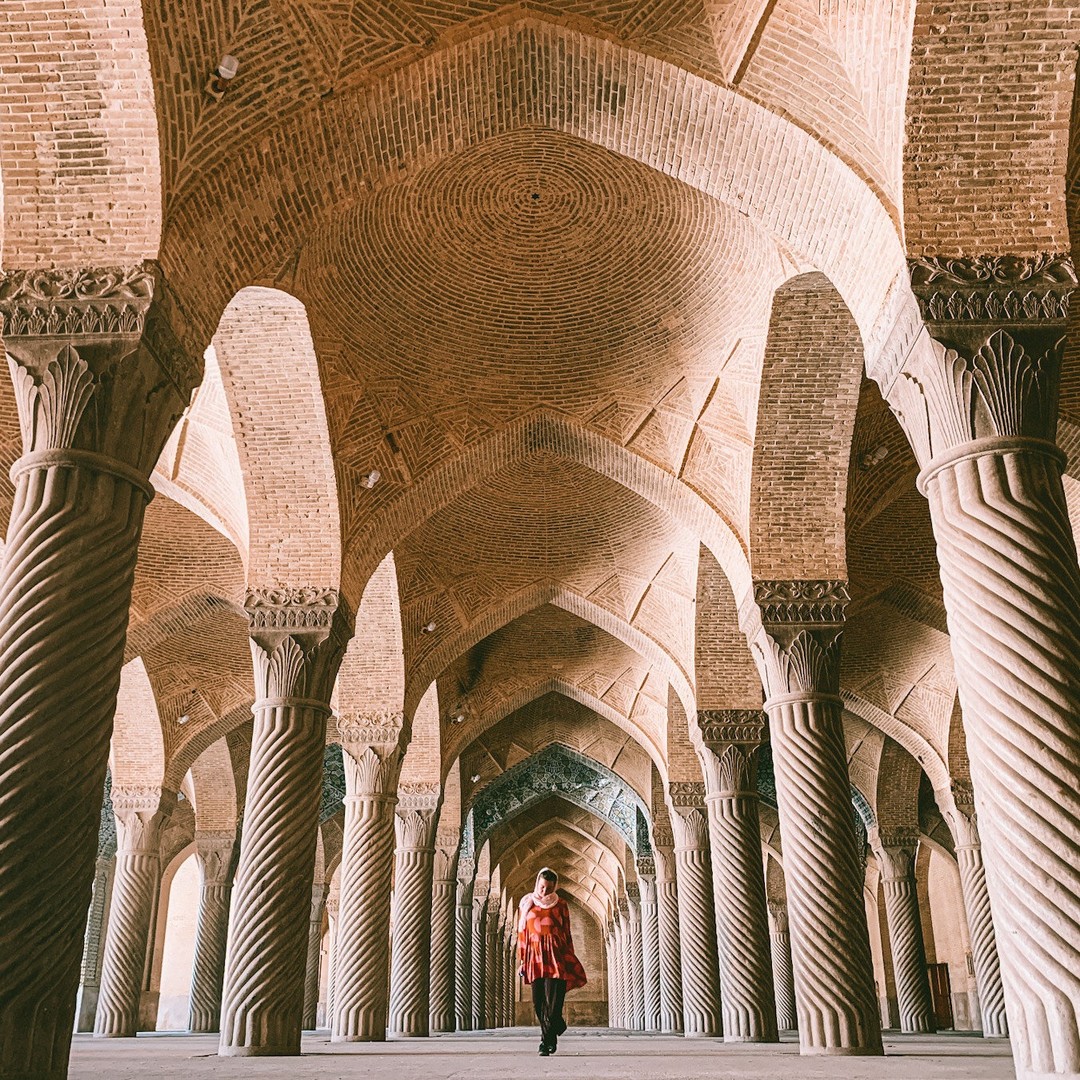
This mosque is built on the east of Kolahfarangi, between Vakkil bathroom and Market and it is considered a masterpiece of the Zand period.
Vakil Mosque was built by the order Karim Khan in the year 1187 A.H. mosque building with an area of about 11.000 square meters consists of a grand entrance, courtyard, north and south arches, east and south Shabestan, east and west porticos, and a small yard. Shabestan of Vakil Mosque has beautiful ceramics, carved pillars, and an integrated fourteen‑step marble pulpit which are of Zand Period masterpieces. this pulpit is the sign of fourteen innocent Imams having fourteen stone steps and then its stone has been brought from Maragheh to Shiraz. north arch of Vakkil Mosque is known as “pearl arch”. it is 12 meters wide and 20 meters long. On top of this arch, there are two beautiful tiled minarets.
Vakil Bazaar
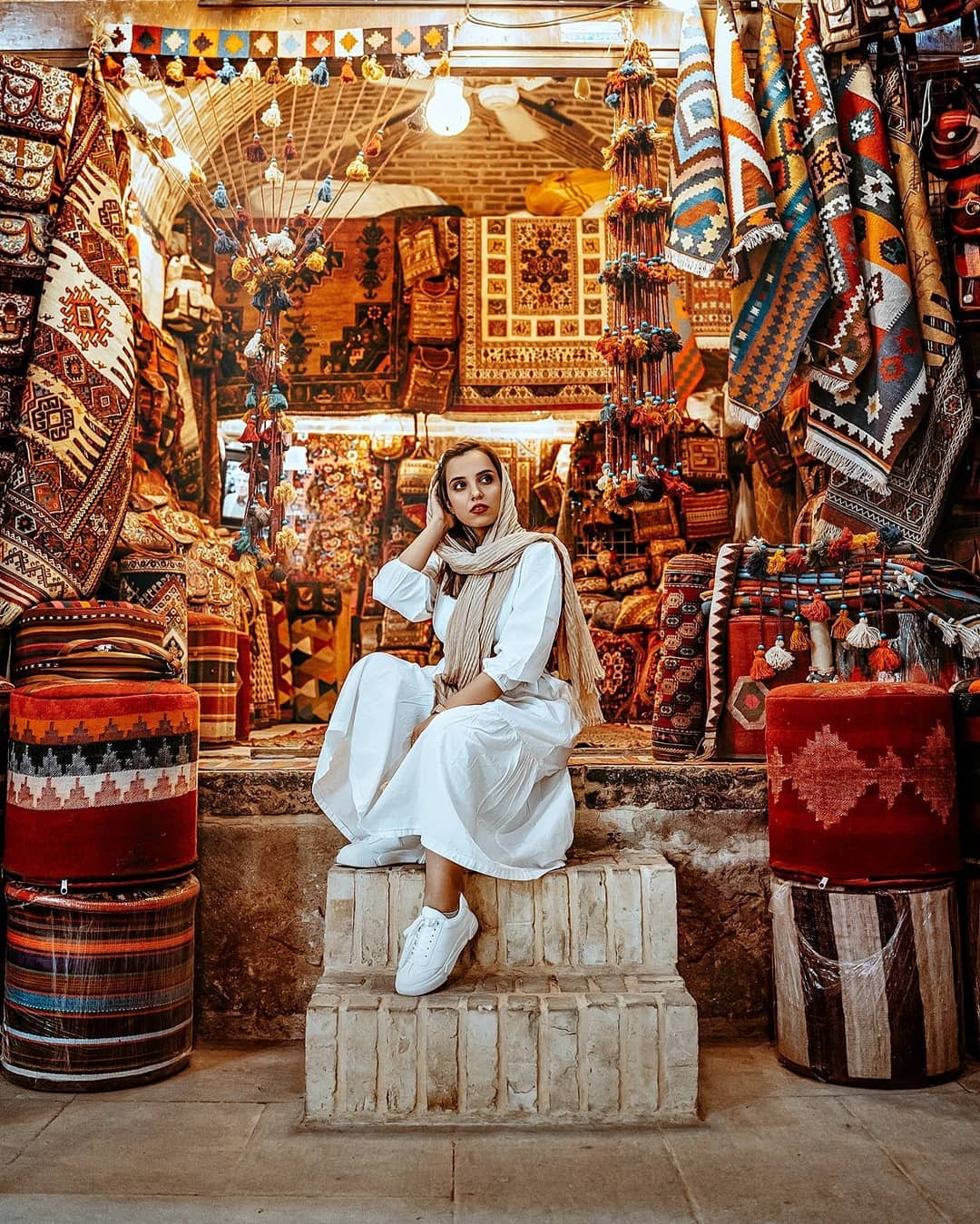
Vakil Bazar would be another architecture and unique masterpiece dating back to the Zand period.
This bazaar has been built around 1180 A.H. like Qeisarieh‑e Lar bazaar‑style (which is related to the Safavid dynasty). Western order (the junction of two great arches are called Chaharsoogh) which has 10 pairs of shops and in the past was known as ” Tarkeshdozha” market, but now it is used as a place for types of Iranian exquisite carpets with 19 pairs of shops and in the past has been known as “Alaqebandan” market, but now is the center of the carpet and grocery stores. Another bath extends from the west side to the south and also moves parallel to the “Tarkeshdozha” market and emerges from in front of Vakil mosque that this part of the market called “Shamshirgarha” market in the past. This market has 10 pairs of stores and on the north side of it “fil Caravanserai” is located. Vakil Bazaar gas 74 well‑established arches which cover the long roof and from outside create an interesting perspective like a camel hump. Height of 10 meters and a skylight of arches have kept the market to be cool in the winter and also warm in the summer, which would be the other characteristics of this market.
Karim Khan Zand for merchants and travelers’ joy and peace and also the market prosperity, other building like inns, customs, warehouses, etc. added to the market.
Karim Khan Zand for merchants and travelers’ joy and peace and also the market prosperity, other building like inns, customs, warehouses, etc. added to the market.
Nasir ol Molk Mosque
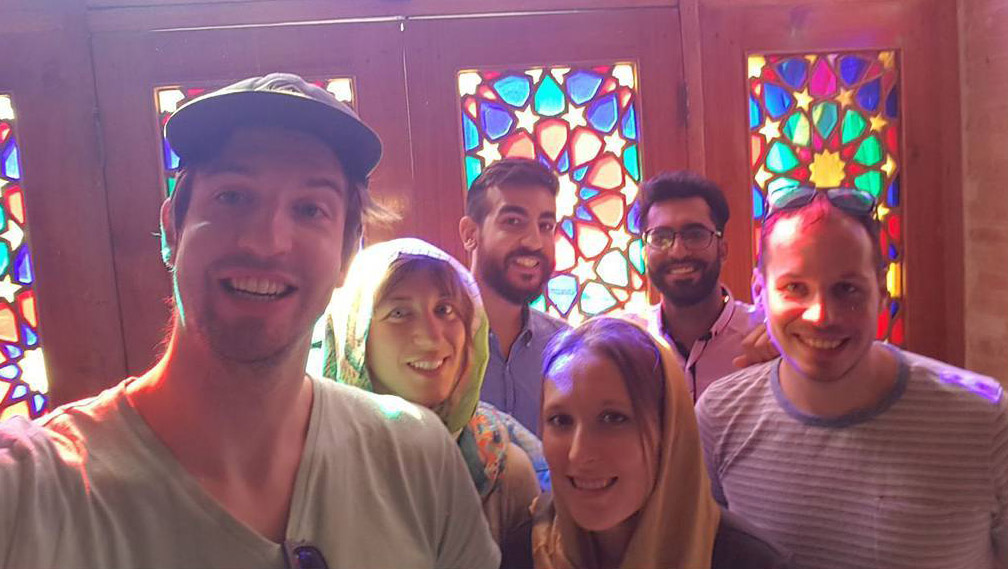
Nasir al‑Mulk Mosque is one of the most beautiful historical mosques of the Qajar era which is placed in Shiraz in the neighborhood of Gowerban and Alatfali Khan Streets.
This mosque was built in the years 1293 to 1305 A.H. by the order of Hasan Ali Nasir al Molk, Mirza Mohammad Hassan. the architect and professor Mohammad Reza, a great tile worker of Qajar reign. This mosque has a large foreground, two North and south porches, an East and West nave, and a beautiful entrance, This place has an area of 2980 square meters and the construction area is 2215 square meters. The western nave of the mosque has seven large wooden doors decorated with stained glass windows and 12 integrated stone columns with spiral grooves in two rows of six to twelve. The nave ceiling is also decorated with floral design, lines, and excellent arabesque verses.
Qavam House

Construction of Naranjestan Qavam was started by Ali Mohammad Khan Qavamolmolk the second in 1290 A.H and ended by his son, Mohammad Reza Khan Qavamolmolk 1305 A.H..
This garden has been the governmental place of Qavamolmolk rulers and for the formation of public and nobles meeting has been used in Qajar reign. This garden due to having vast orange trees known as “Naranjestan”. The total area of this place is of 3085 square meters, about 940 meters occupied by the building itself. this building consists of two floors and a basement one exterior building has been connected to inside the house by a tunnel. Naranjestan has long been the residence of Qavvam family and in 40th s was surrendered to Shiraz university by Ibrahim Qavam. This complex was rebuilt after Islamic revolution and currently has been visited as a museum by tourists.
Shapouri House
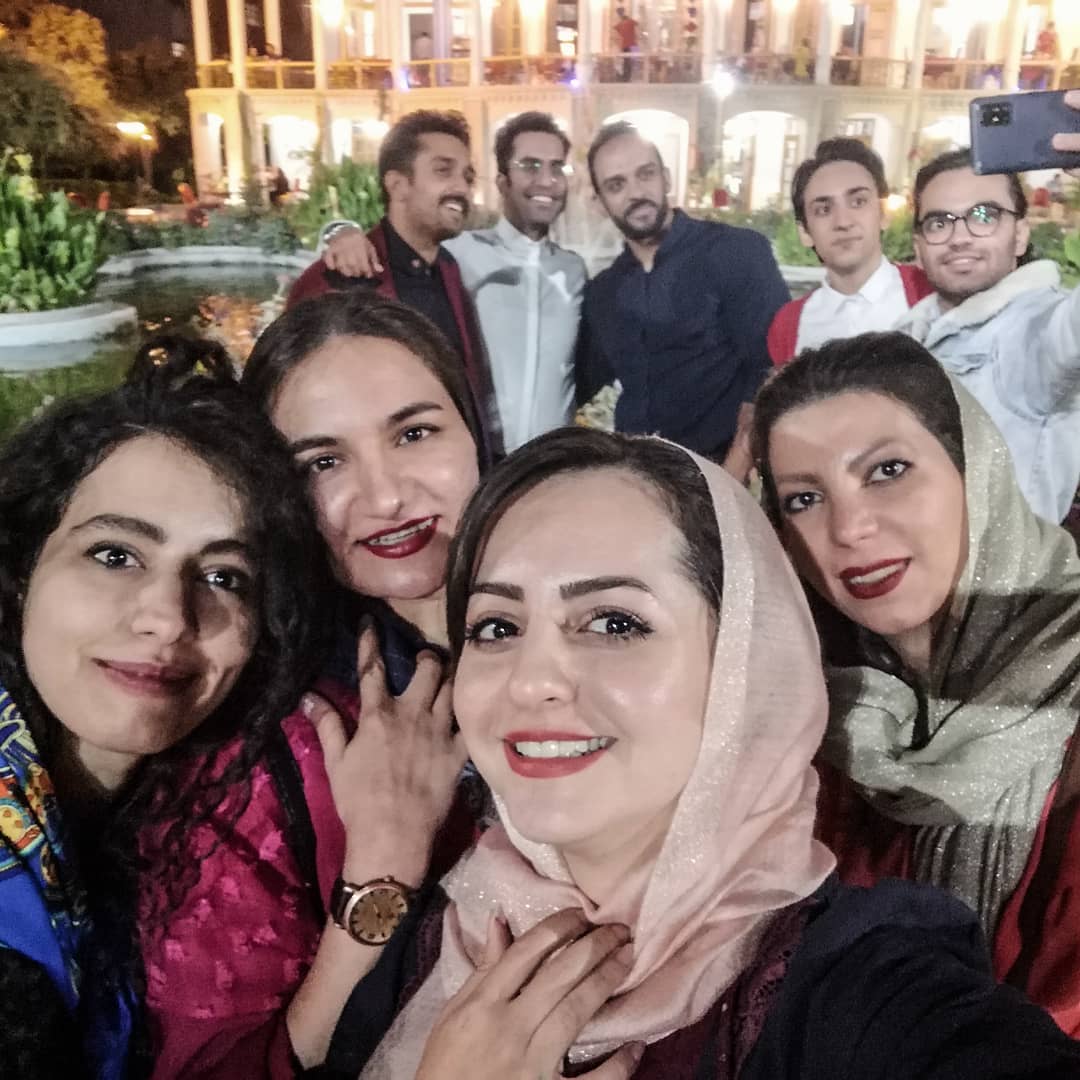
Shapouri House or Shapouri Pavilion and Garden is an early 20th‑century Persian building and garden in the city of Shiraz, Iran.
It has 840 square metres of underpinning and 4635 square metres of garden area, and it is built on two floors. This building is in the old central region of Shiraz, known as Anvari. This mansion was registered as a national building in 2000 with registration number 2781. Shapouri mansion was designed by Abolghasem Mohandesi and built between 1930 and 1935; the owner was Abdolsaheb Shapuori, a wealthy Iranian merchant. This building is unique and very innovative. During the years of 1990 to 2000, Shapouri’s family was living here but after years, the house became vacant. Shapouri House is so specific and distinguished from other historical buildings of the region at that time. It is built in the style of Qajar architecture and is one of the first buildings whose architecture has a free approach.
In Iranian architecture, having a balcony in the building has not been very common, but it has a balcony with 14 pillars that it’s an innovation in Iranian architecture at the time. Also in the design of Shapoori mansion, a staircase has been used which is not seen in any of the buildings of that period. In general, the plan of the mansion was very special and unique in its period.
Upon entering, a big Iranian pool, colorful balcony, wall paintings at top of the stairs, the mirror work, hand painted walls, stucco and traditional decorations comes across, which together create a breathtaking scene. Some of the invaluable features of Shapouri House are the western (major) façade decorations, circular and designed gypsums columns, tilings with achaemenids designs on the upper porch. The trees which planted in this mansion include cedar, maple, sycamore, fig, pomegranate, orange, date and geranium and rose flowers.
This 100‑year‑old monument is so beautiful that it creates a lot of excitement and energy for every viewer. From the beginning of entering the garden, involuntary your eyes involved in the abundant and busy decorations of the facade of the mansion. It is as if you have entered a world of shapes and colors. The monument was registered.
Eram Garden
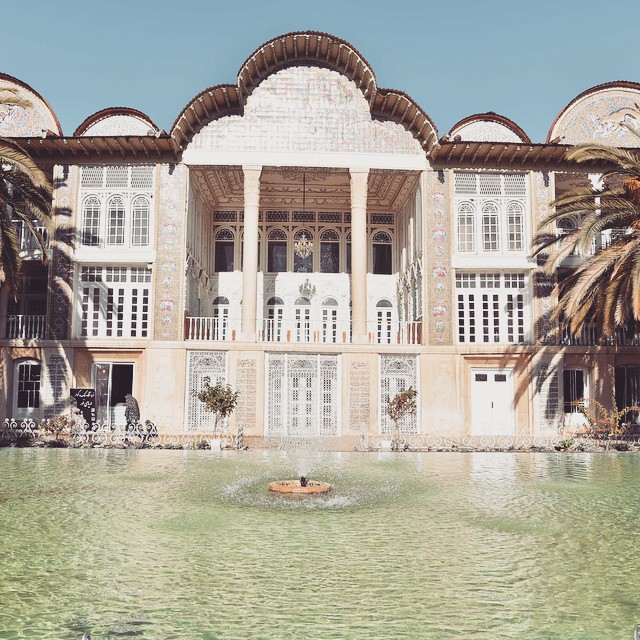
Eram Garden is one of the most famous gardens of Shiraz which is located in the northern part of Shiraz in Eram Street.
The garden’s history dates back to the Seljuk era and has been existed all the time from the Al‑e Injo era. During the Zand dynasty, Karim Khan Zan reconstructed the garden and improved it.
At the end of Zand’s ears and the beginning of the Qajar period, this garden belonged to Qashqaee leaders for 75 years. in the days of Naseraddin Shah Qahar, Hassan Ali Khan Nsirakmolk built a beautiful building in it, but after his death in 1311 A.H., his nephew, Abolqasem Khan (Nsiralmolk the second) took over the garden completed his uncle’s half full building, and ended it in an effective manner which has been remained until now.
Thus valuable monument was built by Haj Mohammad Hassan, a leading architect of the Qajar era. After that due to the garden owners’ debt, it was possessed by the government and then transferred to Shiraz University. This garden has been renovated in the years 1966 to 1971 AD. and in the solar year, 1980 AD. has become a botanical garden.
The most outstanding feature of this building is its two‑store central porch. At the top of the building, there are curved tile designs that include historical, literary, and mythical figures that have been made beautifully. among these figures, could be pointed to Naseraddin Shah on a white horse, Prophet Solomon (PBUH), Yusuf and Zuleikham Ferdowsi and Nezami stories and figure of Darius, the Achaemenids. On the plinth of this monument, the poetry of Sa’adi, Hafez, and Shorideh Shirazi in hieroglyphics 0f Mirza Ali Naqi, calligrapher of Qajar reign have been worked.
At the end of Zand’s ears and the beginning of the Qajar period, this garden belonged to Qashqaee leaders for 75 years. in the days of Naseraddin Shah Qahar, Hassan Ali Khan Nsirakmolk built a beautiful building in it, but after his death in 1311 A.H., his nephew, Abolqasem Khan (Nsiralmolk the second) took over the garden completed his uncle’s half full building, and ended it in an effective manner which has been remained until now.
Thus valuable monument was built by Haj Mohammad Hassan, a leading architect of the Qajar era. After that due to the garden owners’ debt, it was possessed by the government and then transferred to Shiraz University. This garden has been renovated in the years 1966 to 1971 AD. and in the solar year, 1980 AD. has become a botanical garden.
The most outstanding feature of this building is its two‑store central porch. At the top of the building, there are curved tile designs that include historical, literary, and mythical figures that have been made beautifully. among these figures, could be pointed to Naseraddin Shah on a white horse, Prophet Solomon (PBUH), Yusuf and Zuleikham Ferdowsi and Nezami stories and figure of Darius, the Achaemenids. On the plinth of this monument, the poetry of Sa’adi, Hafez, and Shorideh Shirazi in hieroglyphics 0f Mirza Ali Naqi, calligrapher of Qajar reign have been worked.
Quran Gateway
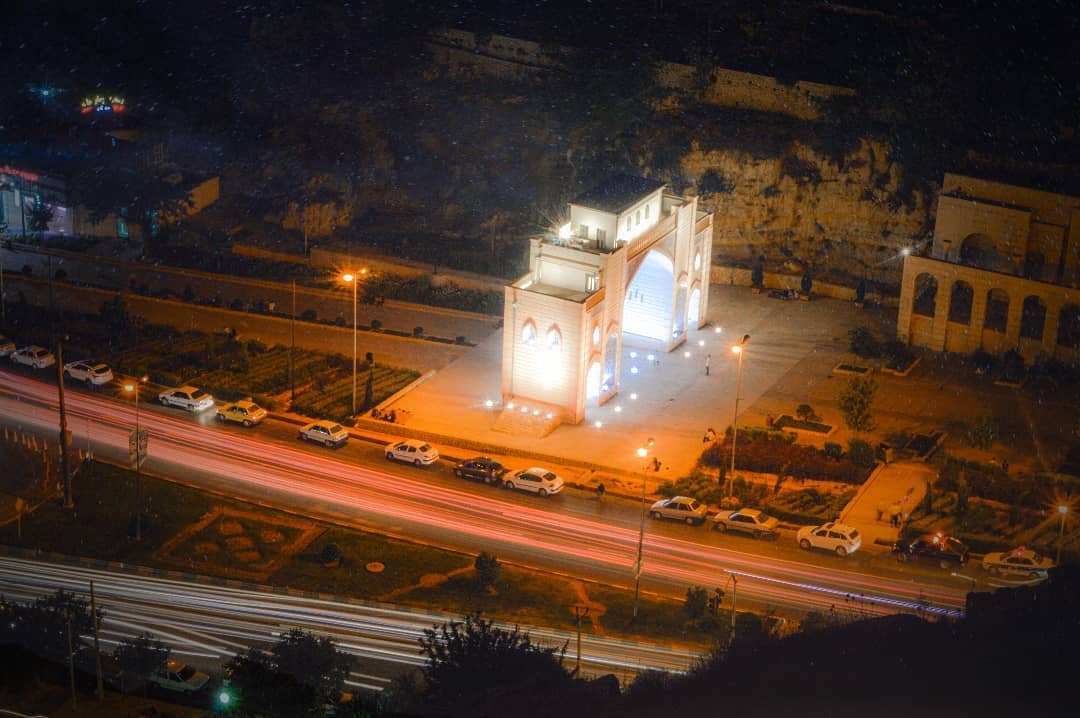
During Deilamian, in the middle of Tang‑e Allaoakbar, at babakouhi Mountain and Chehel Moqam, a tall arch like a gate was build and its founder was knowns as Azzadaddoleh Deilami.
The first construction of this monument was made of stone and plaster. After building this gate, he ordered a large Qur’an known as “SEVENTIN MAN” Qur’am to be put on it for caravans in order to pass under it to wish hem safety in their journey. Since this Quran was put there, the gate named ” Quran Gate” and has been remained in this name until now. This Quran is in two volumes which dates back to Teymorian era and was written in SOLTH and MOHAQAQ line by Ibrahim Sultan. The current structure of Quran Gate was re‑built with an attempt of one of the merchants of Shiraz called “Hossein Aygar” known as “Etemaddal Tojjar” in 1327 A.h.. Tomb of the founder of this gate is placed in east part of this monument.
Gahvareh Did
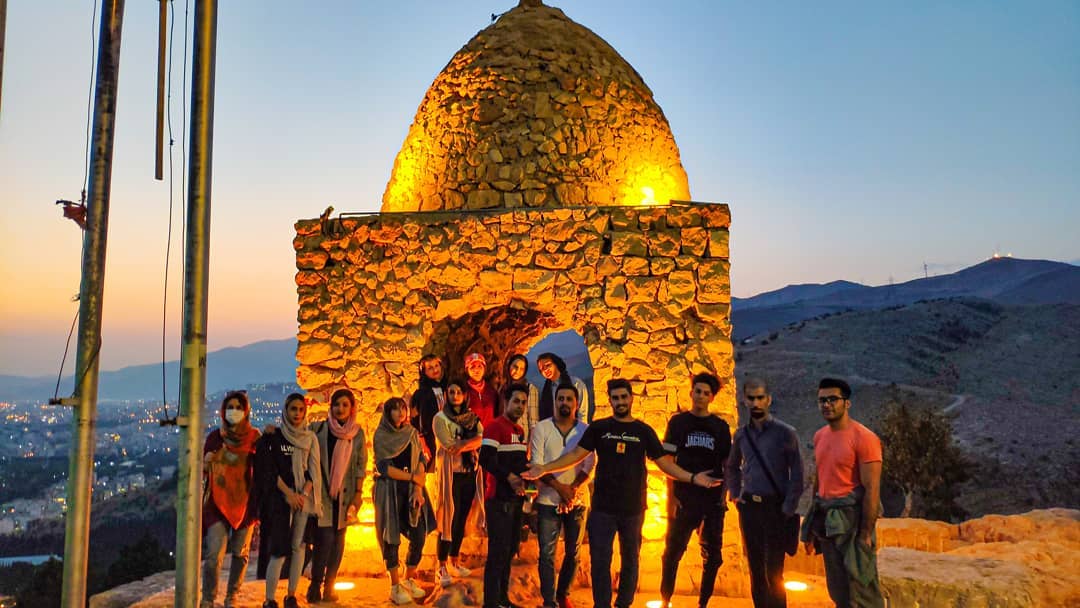
in the solar year of 2002 AD., eight known holy war martyrs were buried beside the Monitoring tower.
on the western peak of the Chehel Moqam Mountain and in front of the gate of Quran, there is a room of 4*4 meters like a dome made of stone and mortar by the gate of Quran was built, he put four archers on a mountain overlooking to the gate, to be used as a place for guards and soldiers watching over the caravans’ movement and the main route of the city. in principle could be seen that the monitoring tower has been a sentinel and reporting tower by which signs and important news are spread to the other parts. To send an urgent and important message, light reflexing from mirrors, smoking, use of horns and trumpets are being used at nights by setting the fire informed the other towers and thus news reached to the capital.
Now, this place is surrounded by trees and is considered one of the beautiful tourist attractions of Shiraz. To travel there, you should pass by the Kohpayeh Garden which is located at the hillside of Chehel Moqam Mountain, and then to reach the top, you should step on the cement stairs made by the municipality of Shiraz city.
Now, this place is surrounded by trees and is considered one of the beautiful tourist attractions of Shiraz. To travel there, you should pass by the Kohpayeh Garden which is located at the hillside of Chehel Moqam Mountain, and then to reach the top, you should step on the cement stairs made by the municipality of Shiraz city.
Babakoohi
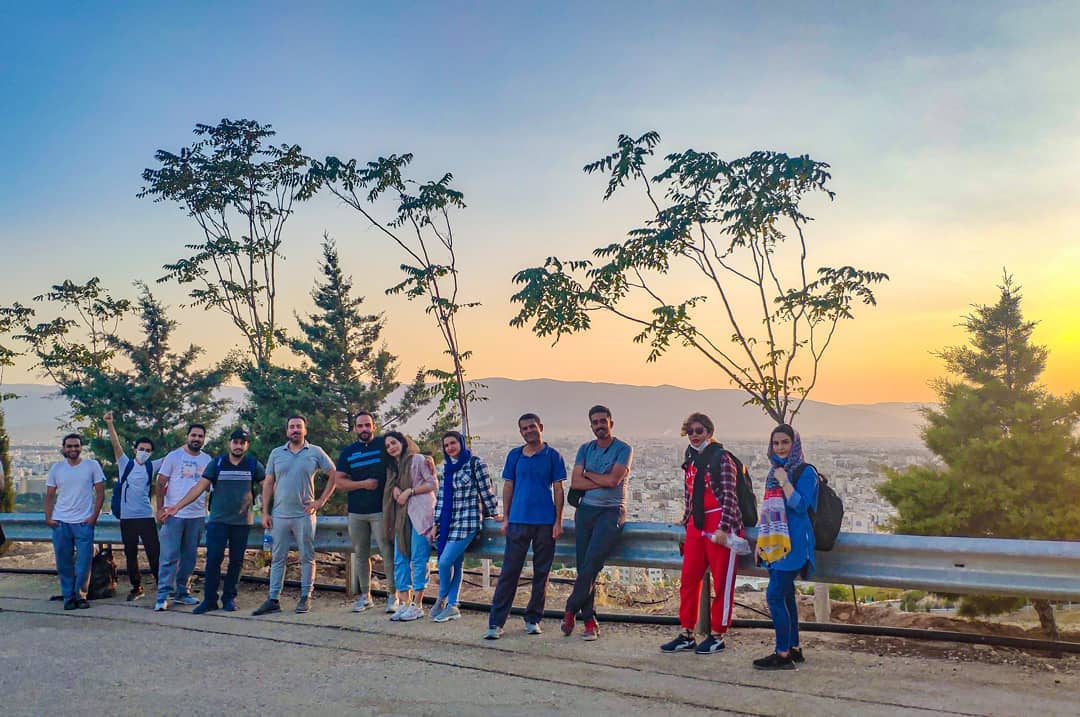
Abomohammad Ibn‑e Obeidalhat was a great Sufi elder of the fourth‑century A.H.
He was known in Arabic sources was recorded as “Abniakoyeh” at the end of his life lived on a hillside to retreat near Shiraz, known as Babakouhi to all people, Abniakoyeh was a disciple of Sheikh Abu Abdullah ibn Khafif and become proficient in various fields, particularly in the Hadith narrating and familiarity with anecdotes and scholars.
Ghalat
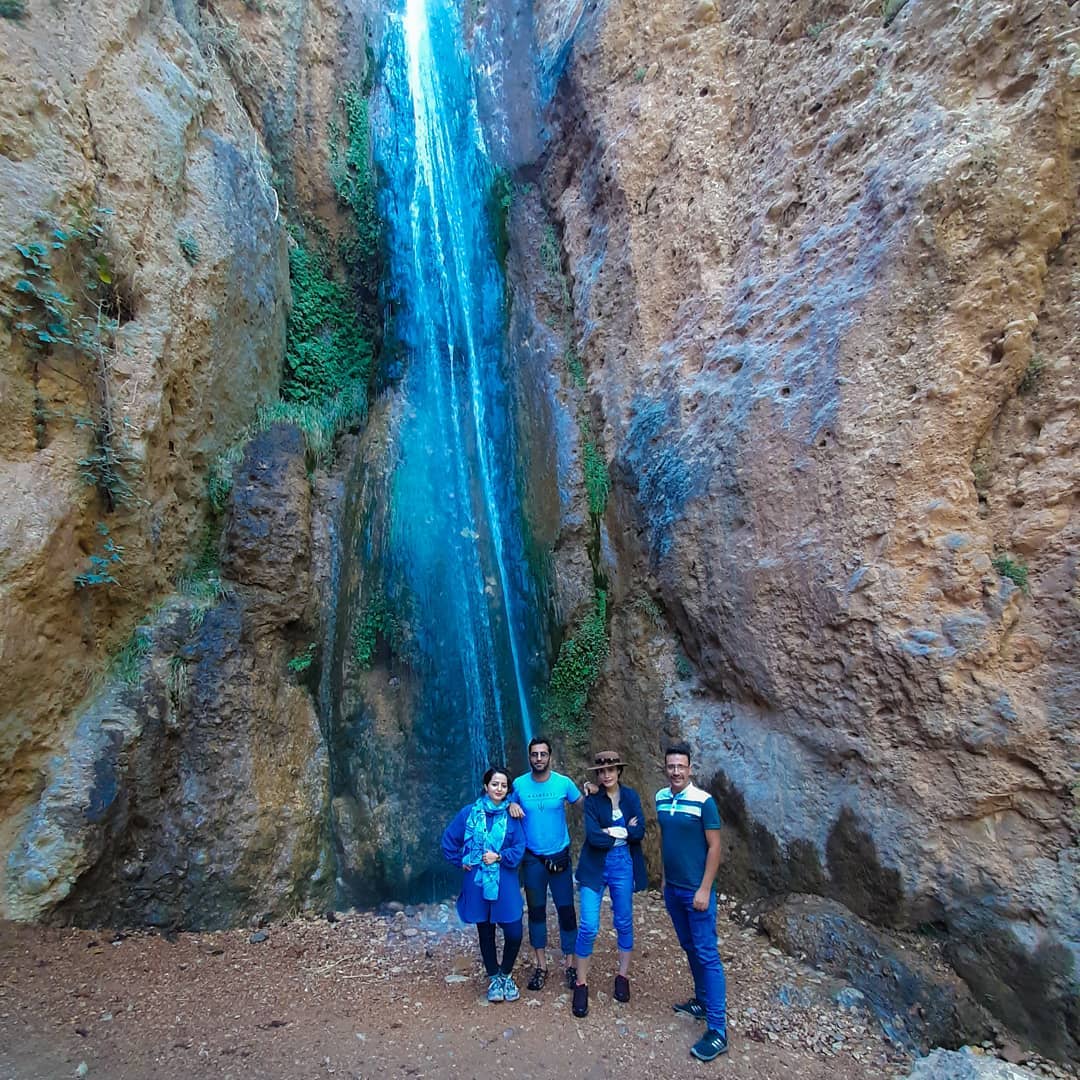
Ghalat Village has located almost 36 Km from the northwestern side of Shiraz.
Perfectly hidden between willow and plane trees, cool weather, and a cozy atmosphere, and being away from the bustle of the city, Ghalat Village is a beautiful oasis to see. If you are interested in rural tourism or hiking a mountain, this is an exceptional choice for you. Let’s have a closer look at this dreamy Village in the Shiraz countryside.
The city of flowers and poems is already filled and surrounded by gardens and greeneries and Ghalat Village is one of the best of them. Ghalat is an old form of the word village and it means somewhere that has steamed springs and good weather. This village is perfect for those who are tired of traffic jams and sound pollution; you can find absolute peacefulness in this place. You just have to listen to the sound of water that is slowly pure from waterfalls and birds singing or enjoy watching the beautiful and green bushes and trees.
The villagers live in houses made of brick, clay, and stone, but like many other old areas, modernization touches the purity of Ghalat Village, and there are some buildings such as restaurants and cafes which are built in a modern way, and they might not be in harmony with old patterns.
The city of flowers and poems is already filled and surrounded by gardens and greeneries and Ghalat Village is one of the best of them. Ghalat is an old form of the word village and it means somewhere that has steamed springs and good weather. This village is perfect for those who are tired of traffic jams and sound pollution; you can find absolute peacefulness in this place. You just have to listen to the sound of water that is slowly pure from waterfalls and birds singing or enjoy watching the beautiful and green bushes and trees.
The villagers live in houses made of brick, clay, and stone, but like many other old areas, modernization touches the purity of Ghalat Village, and there are some buildings such as restaurants and cafes which are built in a modern way, and they might not be in harmony with old patterns.
Persepolis
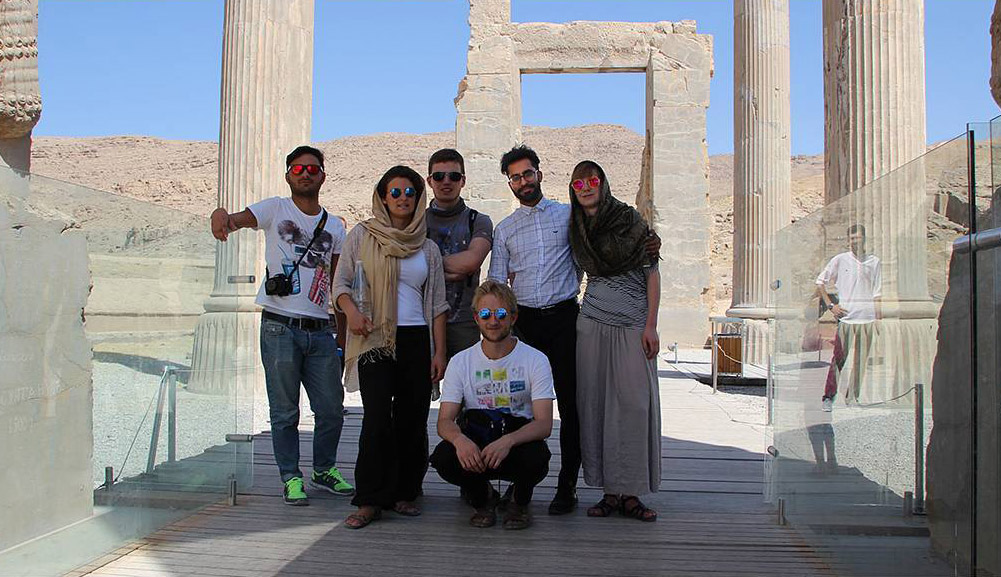
Persepolis was the ceremonial capital of the Achaemenid Empire. It is situated in the plains of Marvdasht, encircled by the southern Zagros mountains of Iran. Modern‑day Shiraz is situated 60 kilometers southwest of the ruins of Persepolis. The earliest remains of Persepolis date back to 515 BC
Kūh‑e Derāk
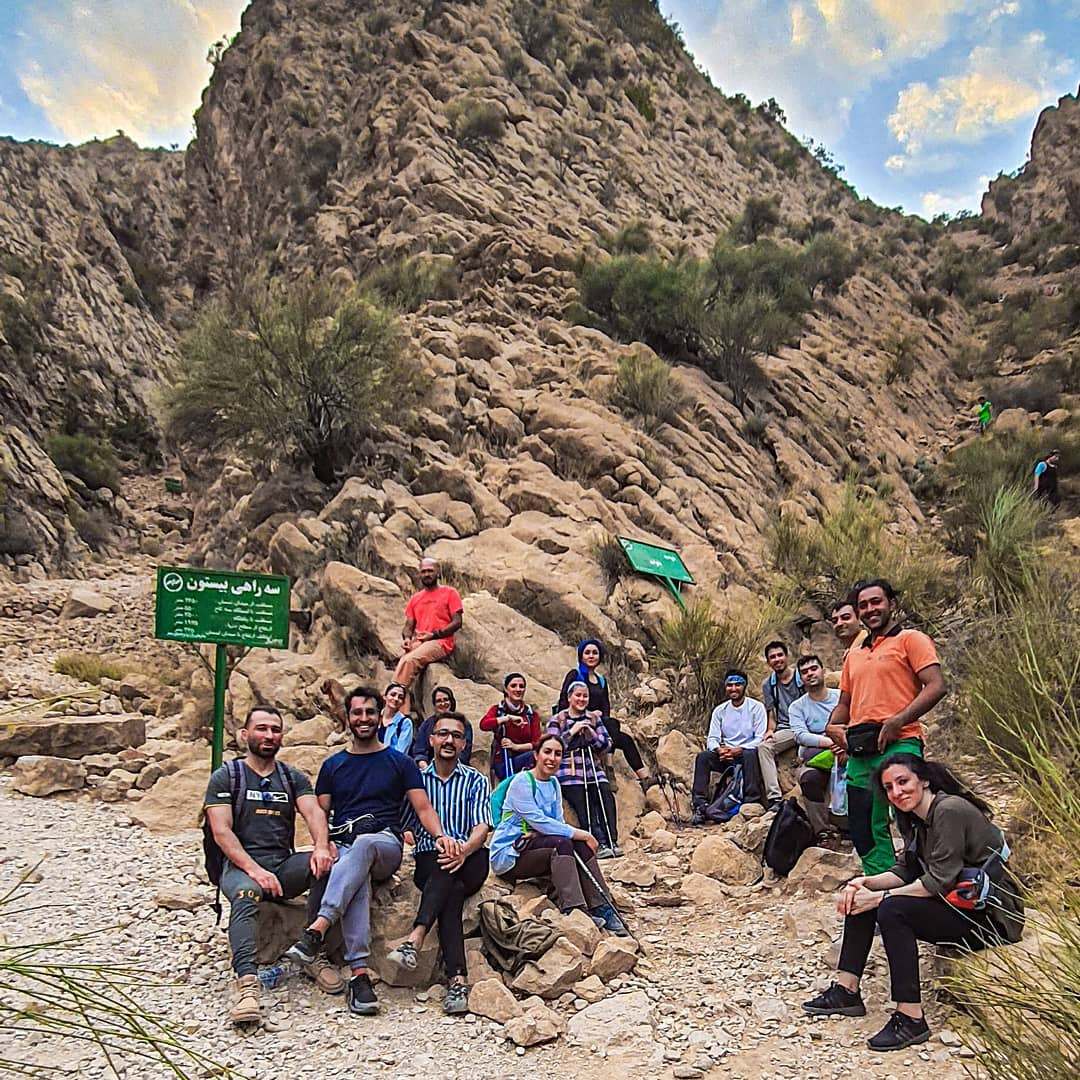
Mount Derak (also known as Kuh Barfi or Mother Mount) is a sedimentary rock mountain in Shiraz, Fars, in the Middle East region in Iran.
It is located west and northwest of Shiraz, Fars. It is called mother mountain because its shape resembles a pregnant woman lying and the name barfi mountain refers to it usually being white‑capped in winter, barf meaning snow in Persian. The mountain’s highest peak is around Shiraz and it is a part of the Zagros Mountains. It is well‑known for its sunsets and as the hub for TV and radio telecommunication masts.
Maharloo Lake

In shiraz after visiting the pink mosque, you can visit the pink lake the other name is maharloo lake because located in maharloo village in sarvestan city near the shiraz. The level of water and hence its pink color changes according to the year so do manage your expectations accordingly.
Articles and Guides
Services
Imporant Links
Information Center
-



© Saeid Zare - Best Iranian Tour Guides 2024
Designed & Developed by frdk.co.ir
Designed & Developed by frdk.co.ir
